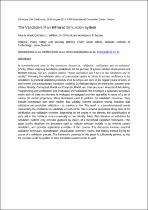JavaScript is disabled for your browser. Some features of this site may not work without it.
- ResearchSpace
- →
- Research Publications/Outputs
- →
- Conference Publications
- →
- View Item
| dc.contributor.author |
De Waal, A

|
|
| dc.contributor.author |
Willers, Cornelius J

|
|
| dc.contributor.author |
Roodt, JHS

|
|
| dc.contributor.author |
Mudau, AE

|
|
| dc.date.accessioned | 2013-11-27T11:55:46Z | |
| dc.date.available | 2013-11-27T11:55:46Z | |
| dc.date.issued | 2013-08 | |
| dc.identifier.citation | De Waal, A, Willers, C.J, Roodt, J.H.S and Mudau, A.E. 2013. The validation of an infrared simulation system. In: SA Incose 10th Conference, 26-28 August 2013, CSIR International Convention Centre, Pretoria | en_US |
| dc.identifier.uri | http://hdl.handle.net/10204/7106 | |
| dc.description | SA Incose 10th Conference, 26-28 August 2013, CSIR International Convention Centre, Pretoria. Abstract only attached. | en_US |
| dc.description.abstract | A commonly-used term in the simulation domain is ‘validation, verification and accreditation’ (VVA). When analysing simulation predictions for the purpose of system solution development and decision-making, one key question persist: “What confidence can I have in the simulation and its results? ” Knowing the validation status of a simulation system is critical to express confidence in the simulation. A practical validation procedure must be simple and done in the regular course of work. A well-known and acknowledged validation model by Schlesinger depicts the interaction between three entities: Reality, Conceptual Model and Computer Model, and three processes: Analysis & Modelling, Programming and Verification, and Evaluation and Validation. We developed a systematic procedure where each of these six elements is evaluated, investigated and then quantified in terms of a set of criteria (or model properties). Many techniques exist to perform the validation procedure. They include: comparison with other models, face validity, extreme condition testing, historical data validation and predictive validation - to mention a few. The result is a two-dimensional matrix representing the confidence in validation of each of the criteria (model properties) along each of the verification and validation elements. Depending on the nature of the element, the quantification of each cell in this matrix is done numerically or heuristically. Most often literature on validation for simulation systems only provides guidance by means of a theoretical validation framework. This paper briefly describes the procedure used to validate software models in an infrared system simulation, and provides application examples of this process. The discussion includes practical validation techniques, quantification, visualisation, summary reports, and lessons learned during the course of a validation process. The framework presented in this paper is sufficiently general, so that the concepts could be applied to other simulation environments as well. | en_US |
| dc.language.iso | en | en_US |
| dc.publisher | INCOSE South Africa | en_US |
| dc.relation.ispartofseries | Workflow;11619 | |
| dc.subject | Infrared simulation systems | en_US |
| dc.subject | Simulation environments | en_US |
| dc.subject | Validation model | en_US |
| dc.title | The validation of an infrared simulation system | en_US |
| dc.type | Conference Presentation | en_US |
| dc.identifier.apacitation | De Waal, A., Willers, C. J., Roodt, J., & Mudau, A. (2013). The validation of an infrared simulation system. INCOSE South Africa. http://hdl.handle.net/10204/7106 | en_ZA |
| dc.identifier.chicagocitation | De Waal, A, Cornelius J Willers, JHS Roodt, and AE Mudau. "The validation of an infrared simulation system." (2013): http://hdl.handle.net/10204/7106 | en_ZA |
| dc.identifier.vancouvercitation | De Waal A, Willers CJ, Roodt J, Mudau A, The validation of an infrared simulation system; INCOSE South Africa; 2013. http://hdl.handle.net/10204/7106 . | en_ZA |
| dc.identifier.ris | TY - Conference Presentation AU - De Waal, A AU - Willers, Cornelius J AU - Roodt, JHS AU - Mudau, AE AB - A commonly-used term in the simulation domain is ‘validation, verification and accreditation’ (VVA). When analysing simulation predictions for the purpose of system solution development and decision-making, one key question persist: “What confidence can I have in the simulation and its results? ” Knowing the validation status of a simulation system is critical to express confidence in the simulation. A practical validation procedure must be simple and done in the regular course of work. A well-known and acknowledged validation model by Schlesinger depicts the interaction between three entities: Reality, Conceptual Model and Computer Model, and three processes: Analysis & Modelling, Programming and Verification, and Evaluation and Validation. We developed a systematic procedure where each of these six elements is evaluated, investigated and then quantified in terms of a set of criteria (or model properties). Many techniques exist to perform the validation procedure. They include: comparison with other models, face validity, extreme condition testing, historical data validation and predictive validation - to mention a few. The result is a two-dimensional matrix representing the confidence in validation of each of the criteria (model properties) along each of the verification and validation elements. Depending on the nature of the element, the quantification of each cell in this matrix is done numerically or heuristically. Most often literature on validation for simulation systems only provides guidance by means of a theoretical validation framework. This paper briefly describes the procedure used to validate software models in an infrared system simulation, and provides application examples of this process. The discussion includes practical validation techniques, quantification, visualisation, summary reports, and lessons learned during the course of a validation process. The framework presented in this paper is sufficiently general, so that the concepts could be applied to other simulation environments as well. DA - 2013-08 DB - ResearchSpace DP - CSIR KW - Infrared simulation systems KW - Simulation environments KW - Validation model LK - https://researchspace.csir.co.za PY - 2013 T1 - The validation of an infrared simulation system TI - The validation of an infrared simulation system UR - http://hdl.handle.net/10204/7106 ER - | en_ZA |






